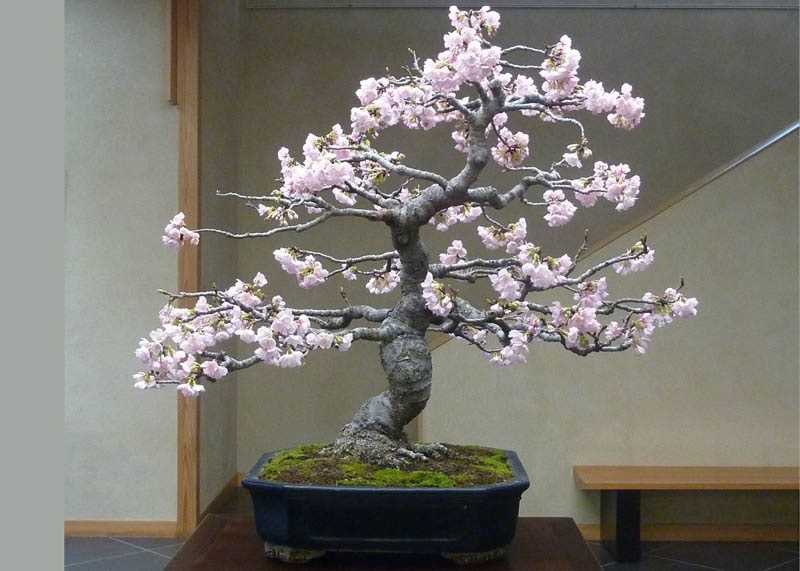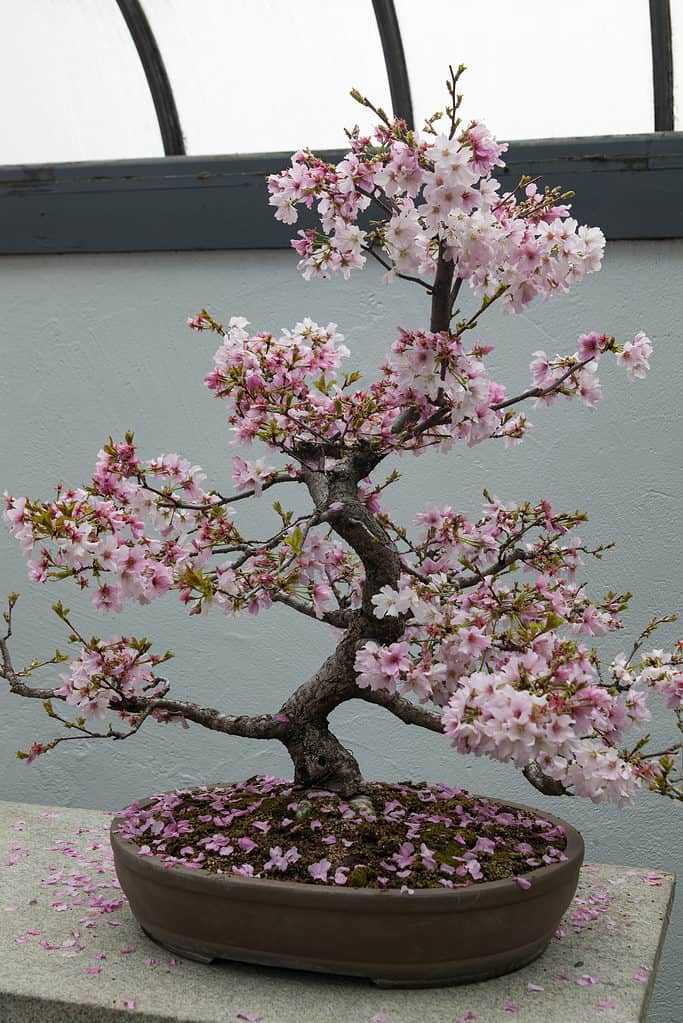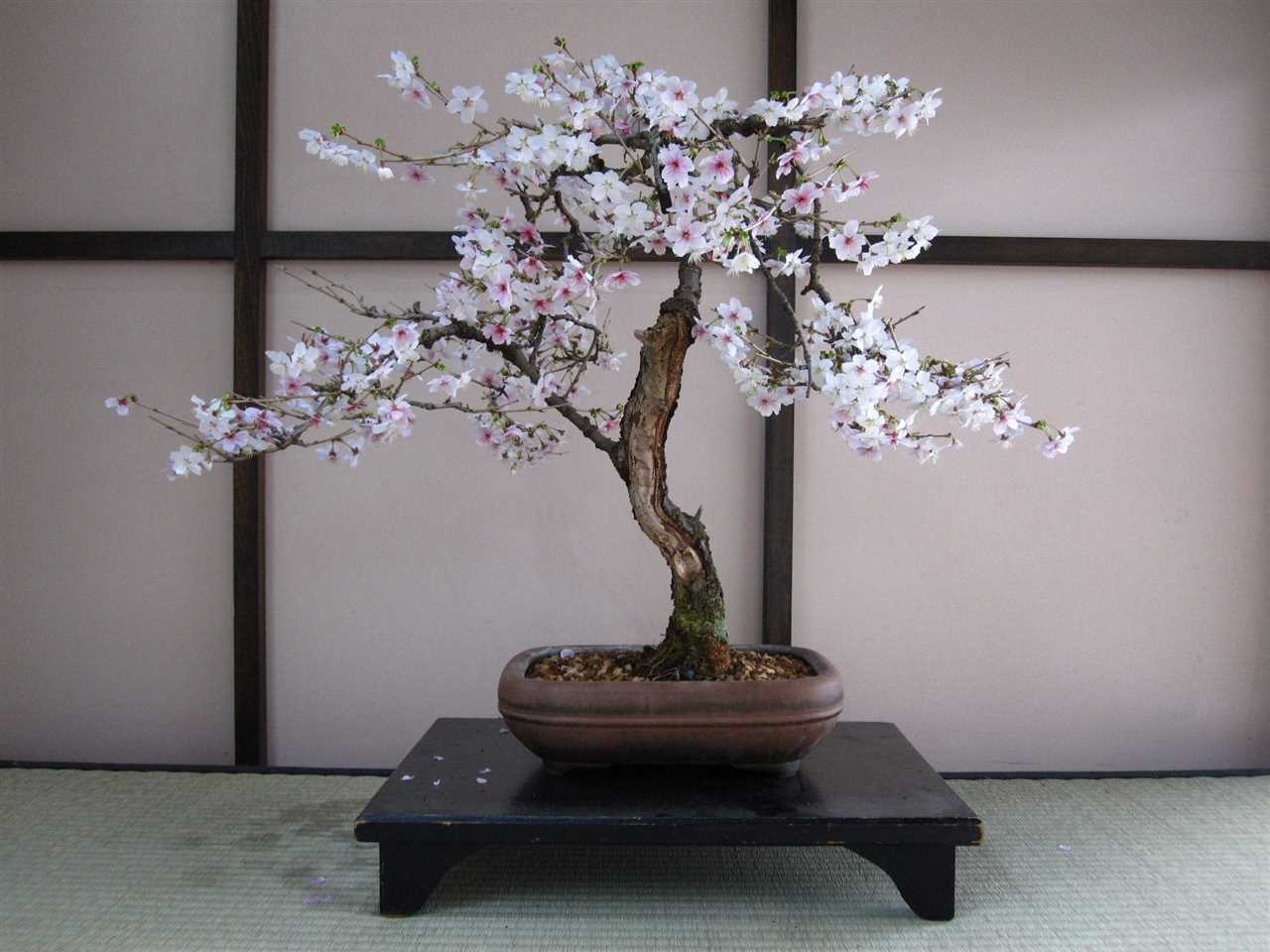Contents
- 1 Discover the Beauty of Bonsai Cherry Blossom A Guide to Growing and Caring for These Exquisite Trees
Discover the Beauty of Bonsai Cherry Blossom A Guide to Growing and Caring for These Exquisite Trees

Experience the elegance and tranquility of Japanese culture with our exquisite Bonsai Cherry Blossom trees. These stunning plants are not only a sight to behold, but also a symbol of beauty and harmony.
What makes our Bonsai Cherry Blossom trees so special?
Each tree is carefully cultivated to mimic the natural beauty of a cherry blossom tree in its full bloom. Our expert growers pay meticulous attention to every detail, from the delicate branches to the vibrant pink flowers.
Why choose a Bonsai Cherry Blossom tree?
These miniature trees bring the beauty of nature into your home or office, creating a peaceful and serene atmosphere. With their compact size, they are perfect for any space, whether it’s a small apartment or a spacious garden.
Whether you are an experienced gardener or a beginner, our comprehensive guide will provide you with all the information you need to grow and care for your Bonsai Cherry Blossom tree. From selecting the right pot to pruning and shaping the branches, our step-by-step instructions will ensure that your tree thrives and flourishes.
Bring the enchanting beauty of Japanese cherry blossoms into your life with our Bonsai Cherry Blossom trees. Order yours today and experience the serenity and elegance they bring to any space.
History and Origins

The bonsai cherry tree, also known as Prunus serrulata, is a beautiful flowering tree that is native to Japan. It is a popular choice for bonsai enthusiasts due to its delicate pink or white blossoms, which symbolize the beauty and transient nature of life.
Cherry blossoms have been a cherished part of Japanese culture for centuries. The tradition of cherry blossom viewing, known as hanami, dates back to the 8th century. During this time, the Japanese nobility would gather under the blooming cherry trees to appreciate their beauty and celebrate the arrival of spring.
Over time, cherry blossoms became a symbol of renewal and the fleeting nature of life. The short-lived blossoms serve as a reminder to live in the present moment and appreciate the beauty that surrounds us.
The art of bonsai, which originated in China and was later refined by the Japanese, involves carefully shaping and pruning trees to create miniature versions that mimic the appearance of full-sized trees. Bonsai cherry trees are a popular choice for bonsai enthusiasts due to their elegant branches and stunning blossoms.
Creating a bonsai cherry tree requires patience and skill. The tree must be carefully pruned and shaped to maintain its miniature size and create the desired aesthetic. With proper care and attention, a bonsai cherry tree can thrive in a garden or indoor setting, bringing the beauty of nature into your home.
Significance and Symbolism

The bonsai cherry blossom tree holds great significance and symbolism in Japanese culture. It is not just a plant or a tree, but a representation of beauty, nature, and the transient nature of life.
The cherry blossom, or sakura, is a beloved symbol in Japan. It is a reminder of the fleeting beauty of life, as the blossoms only last for a short period of time. The cherry blossom season, known as hanami, is celebrated with festivals and gatherings in parks and gardens throughout the country.
By growing a bonsai cherry blossom tree in your garden, you can bring the beauty and symbolism of the cherry blossom into your own home. It is a way to connect with nature and appreciate the delicate beauty of the blossoms.
The bonsai cherry blossom tree is a miniature version of the full-sized cherry tree, with carefully pruned branches and a compact size. It requires special care and attention to maintain its shape and health.
When the cherry blossom tree blooms, it is a sight to behold. The delicate pink or white blossoms cover the branches, creating a stunning display of color and beauty. The blossoms are often associated with renewal and the arrival of spring.
Whether you are a seasoned bonsai enthusiast or just starting out, growing a bonsai cherry blossom tree is a rewarding experience. It requires patience, dedication, and a love for nature, but the end result is a beautiful and meaningful addition to your garden.
Popular Varieties

There are several popular varieties of bonsai cherry trees that are highly sought after by collectors and enthusiasts. These varieties showcase the beauty and elegance of the cherry blossom in a miniature form.
- Prunus serrulata – This is the most common variety of bonsai cherry tree. It is known for its delicate pink flowers and beautiful branch structure.
- Prunus incisa – Also known as the Fuji cherry, this variety is characterized by its small white flowers and compact growth habit.
- Prunus subhirtella – The weeping cherry tree is a popular choice for bonsai enthusiasts. It features cascading branches and delicate pink flowers.
- Prunus avium – The wild cherry tree is known for its profusion of white flowers and glossy green leaves. It is a favorite among bonsai gardeners.
These popular varieties of bonsai cherry trees can be grown and cared for in your own garden or indoor space. With proper attention and care, these exquisite trees will bring beauty and tranquility to any environment.
Growing Bonsai Cherry Blossom

Are you a fan of the delicate beauty of cherry blossoms? Why not bring that beauty into your own garden with a bonsai cherry blossom tree? Bonsai cherry blossoms are miniature versions of the iconic Japanese trees, carefully cultivated to capture their essence in a small, manageable form.
When it comes to growing bonsai cherry blossom trees, there are a few key things to keep in mind. First, you’ll need to choose the right cherry tree variety. Some popular choices include the Yoshino cherry, Kwanzan cherry, and Okame cherry. Each variety has its own unique characteristics and blossom color, so choose the one that speaks to you.
Once you’ve selected your cherry tree, it’s time to start the bonsai cultivation process. This involves carefully pruning and shaping the tree to achieve the desired form. Bonsai pruning is an art form in itself, requiring patience and attention to detail. By carefully trimming branches and leaves, you can create a miniature masterpiece that captures the essence of a full-sized cherry blossom tree.
Proper care is also essential for the health and beauty of your bonsai cherry blossom tree. Make sure to provide adequate sunlight, water, and nutrients to keep your tree thriving. Bonsai trees are typically grown in pots, so it’s important to choose the right soil mix and pot size to promote healthy root growth.
One of the most rewarding aspects of growing bonsai cherry blossoms is watching them bloom. The delicate pink or white blossoms add a touch of elegance to any garden or indoor space. The blooming period typically lasts for a few weeks, so make sure to savor the beauty while it lasts.
Whether you’re an experienced bonsai enthusiast or a beginner looking to try something new, growing bonsai cherry blossoms is a rewarding and fulfilling hobby. These miniature trees capture the essence of nature’s beauty in a small, manageable form. Start your bonsai journey today and discover the joy of growing your own bonsai cherry blossom tree.
Choosing the Right Tree

When it comes to creating a beautiful bonsai cherry blossom tree, selecting the right plant is essential. Here are some key factors to consider when choosing your cherry blossom bonsai:
- Species: There are several species of cherry trees that are commonly used for bonsai, such as the Japanese cherry (Prunus serrulata) and the Taiwan cherry (Prunus campanulata). Each species has its own unique characteristics, so it’s important to research and choose the one that best suits your preferences.
- Branch Structure: Look for a tree with a well-developed branch structure. The branches should be evenly distributed and have a pleasing shape. Avoid trees with branches that are too sparse or too crowded.
- Blossom Quality: The beauty of a cherry blossom bonsai lies in its delicate and vibrant flowers. Choose a tree that has a history of producing abundant and high-quality blossoms. Look for trees with flowers that are evenly distributed and have a vibrant color.
- Health: A healthy tree is essential for successful bonsai cultivation. Inspect the tree for signs of pests, diseases, or any other health issues. Choose a tree that is free from any visible problems and shows signs of vitality.
- Growth Potential: Consider the growth potential of the tree. Some cherry tree species have a slower growth rate, which can make them more suitable for bonsai cultivation. If you’re a beginner, it’s advisable to choose a tree with a moderate growth rate that is easier to manage.
By considering these factors and taking your time to choose the right tree, you can ensure that your bonsai cherry blossom tree will thrive and bring beauty to your garden for years to come.
Soil and Potting

Choosing the right soil and potting mix is essential for the health and growth of your bonsai cherry tree. The soil should provide proper drainage while retaining enough moisture for the plant to thrive. Here are some key considerations when it comes to soil and potting:
- Well-Draining Soil: Bonsai cherry trees prefer soil that drains well to prevent waterlogged roots. A mix of akadama, pumice, and lava rock is commonly used for bonsai cultivation.
- Moisture Retention: While it’s important for the soil to drain well, it should also retain enough moisture to keep the cherry tree hydrated. Adding sphagnum moss or coconut coir to the mix can help retain moisture.
- Acidic pH: Bonsai cherry trees prefer slightly acidic soil with a pH range of 5.5 to 6.5. You can adjust the pH level by adding organic matter or using specific bonsai soil mixes designed for acid-loving plants.
When it comes to potting your bonsai cherry tree, consider the following:
- Size: Choose a pot that is appropriate for the size of your bonsai tree. A pot that is too big can hinder root development, while a pot that is too small may restrict growth.
- Material: Opt for a pot made of ceramic or clay, as these materials provide better insulation and allow for proper airflow to the roots.
- Drainage Holes: Ensure that the pot has sufficient drainage holes to prevent water from accumulating and causing root rot.
Proper soil and potting are crucial for the overall health and vitality of your bonsai cherry tree. By selecting the right soil mix and pot, you can create an ideal environment for your tree to flourish and showcase its beautiful cherry blossoms.
Watering and Fertilization

Proper watering and fertilization are essential for the health and beauty of your bonsai cherry blossom tree. Here are some tips to help you care for your tree:
- Watering: Bonsai trees have specific watering needs. It is important to keep the soil moist but not soggy. Check the soil regularly by inserting your finger into the soil up to the second knuckle. If it feels dry at this depth, it’s time to water your tree. Water the tree thoroughly, making sure that the water reaches the roots. Avoid over-watering as it can lead to root rot.
- Fertilization: Fertilizing your bonsai cherry blossom tree is necessary to provide it with the nutrients it needs to thrive. Use a balanced, slow-release fertilizer designed for bonsai trees. Follow the instructions on the package for the correct dosage and frequency of application. Fertilize your tree during the growing season, typically from spring to fall, and reduce or stop fertilization during the winter months when the tree is dormant.
- Timing: It is important to water and fertilize your bonsai cherry blossom tree at the right time. Water your tree early in the morning or late in the evening to avoid evaporation. Fertilize your tree when it is actively growing to maximize nutrient absorption.
- Observation: Pay attention to the needs of your bonsai cherry blossom tree. Observe the leaves and branches for any signs of stress or nutrient deficiencies. Yellowing leaves may indicate over-watering or lack of nutrients, while wilting leaves may indicate under-watering. Adjust your watering and fertilization practices accordingly to maintain the health of your tree.
By following these watering and fertilization tips, you can ensure that your bonsai cherry blossom tree thrives and continues to delight you with its beautiful flowers.
Caring for Bonsai Cherry Blossom

Are you a garden enthusiast who loves the beauty and elegance of flowers? If so, then you must consider adding a bonsai cherry blossom tree to your collection. These exquisite trees, native to Japan, are a perfect addition to any garden or indoor space.
When caring for a bonsai cherry blossom tree, it is important to remember that it requires special attention and care. Here are some tips to help you ensure the health and beauty of your tree:
- Placement: Place your bonsai cherry blossom tree in a location where it will receive plenty of sunlight. These trees thrive in bright, indirect light.
- Watering: Water your tree regularly, keeping the soil moist but not soaked. It is important to avoid overwatering, as this can lead to root rot.
- Pruning: Prune your bonsai cherry blossom tree regularly to maintain its shape and promote healthy growth. Remove any dead or damaged branches, and trim back new growth to maintain the desired shape.
- Fertilizing: Fertilize your tree with a balanced bonsai fertilizer during the growing season. This will provide the necessary nutrients for healthy growth and vibrant blooms.
- Temperature and Humidity: Bonsai cherry blossom trees prefer cooler temperatures and higher humidity levels. Avoid placing your tree near drafts or in areas with extreme temperature fluctuations.
- Protection: Protect your bonsai cherry blossom tree from pests and diseases by regularly inspecting the leaves and branches. If you notice any signs of damage or infestation, take immediate action to prevent further harm.
By following these care tips, you can enjoy the beauty of your bonsai cherry blossom tree for years to come. Whether you choose to display it in your garden or indoors, this stunning tree is sure to bring joy and tranquility to your space.
Video:Discover the Beauty of Bonsai Cherry Blossom A Guide to Growing and Caring for These Exquisite Trees
Hello, I am Beverly J. Sanders, the voice behind the diverse articles you come across on styves.co.za. My passion lies in exploring the nuances of home improvement and sharing tips that can help you transform your living space into a haven of comfort and style. From the latest trends in home decor to practical cleaning advice, I cover a broad spectrum of topics to cater to a wide variety of interests.
In my recent works, I have delved into the advantages of incorporating a horizontal Murphy bed into your home to save space without compromising on design and functionality. I also explored the benefits of having a free-standing electric fireplace that not only adds warmth to your home but also brings a sleek and modern design to any living space. My articles are a rich resource, offering insights into different products and home improvement strategies that can enhance the quality of your life.
I believe in the power of details; a belief that reflects in my comprehensive guides where I discuss even the overlooked aspects of home decor, such as the impact of baseboard trim in enhancing the overall look and feel of your home. I am constantly on the lookout for innovative solutions and products that can add value to your home and life.
Join me in my exploration as I continue to bring you the latest trends, tips, and insights in the home improvement world. Let’s create a home that is not just a place to live, but a reflection of style and personality.